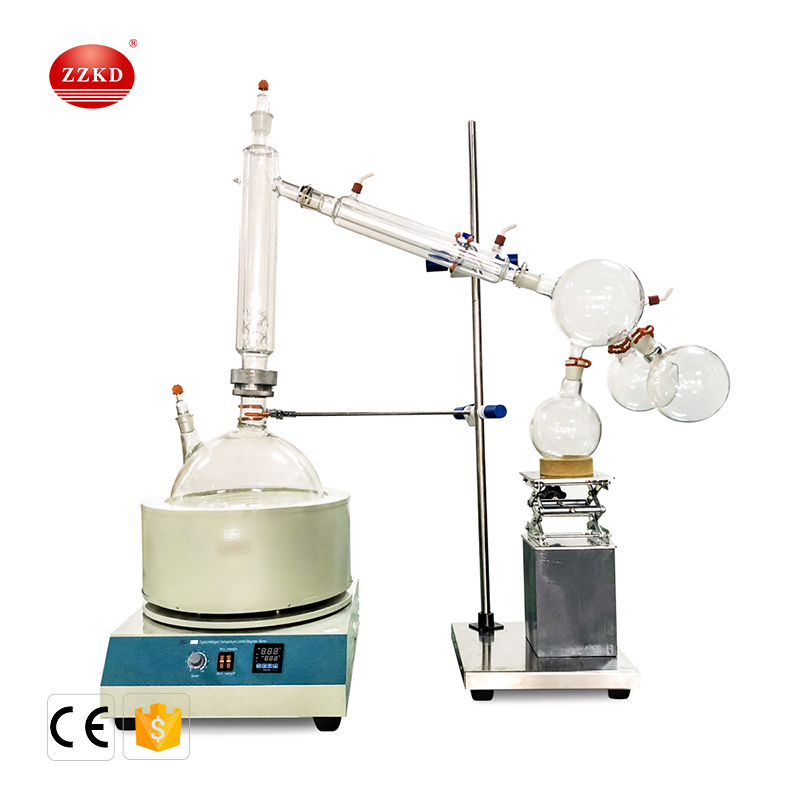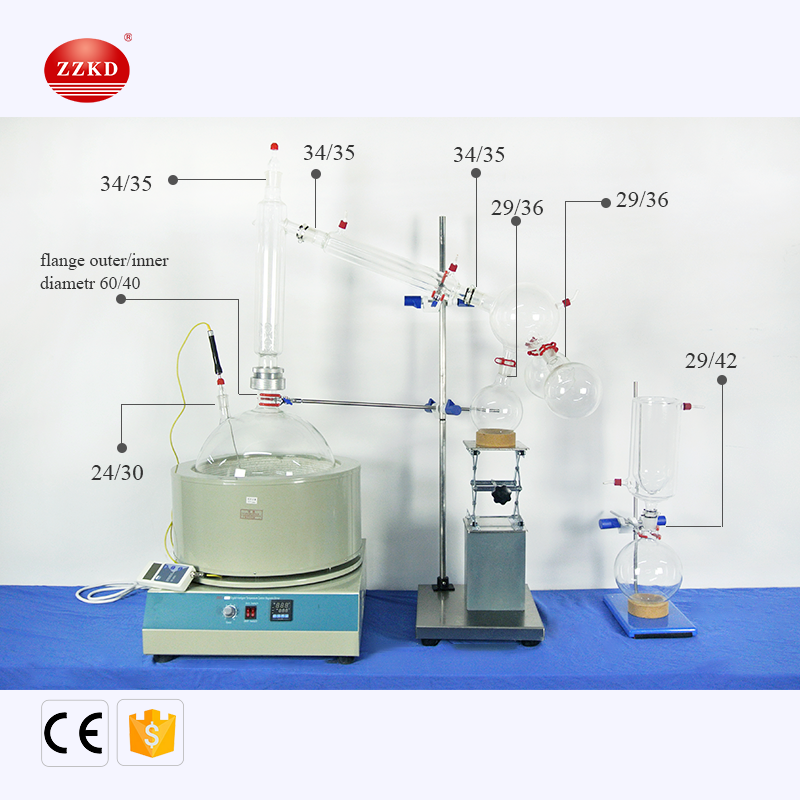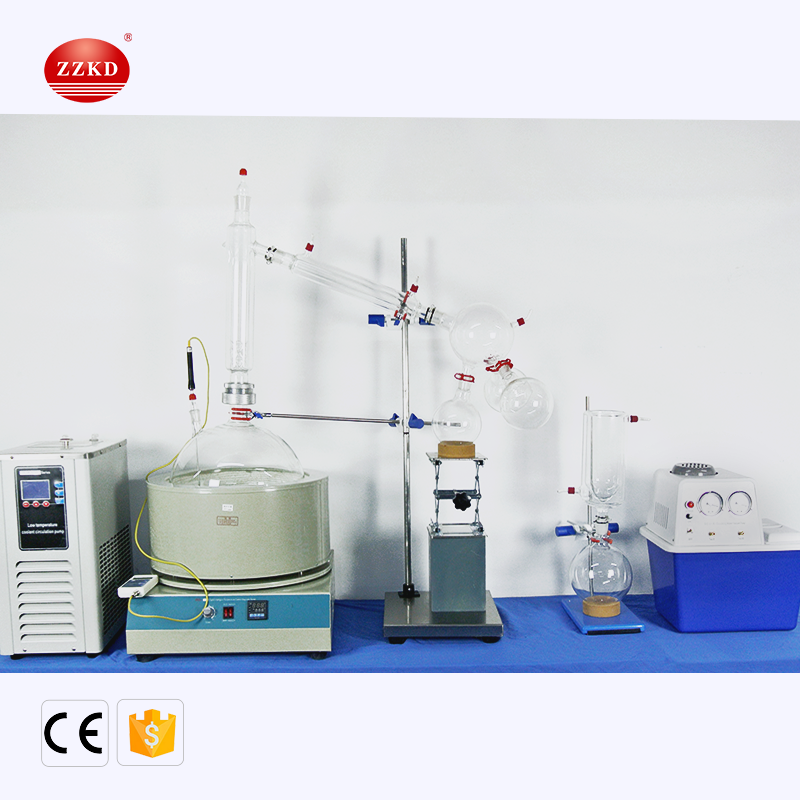Complete Short Path Distillation Kit Procedure
Before using the complete short path ditilation unit for the first time, it is necessary to understand its working principle and precautions to avoid operating errors and losses during use. The following is an introduction to the working principle of the short-path distiller.
A short path distillation kit is a device for distillation methods operating under high vacuum. The short-range molecular distiller is divided into three types according to the form of the wiper: rolling type, sliding wiper type, hinge wiper type, according to the viscosity and processing properties of the material, choose the appropriate wiper. The working principle of the short-path distiller: The short-path distiller is a distillation process in which the molecules evaporated on the heating surface travel as short as possible to the condensation surface for condensation under high vacuum conditions, thereby realizing liquid-liquid separation. When the distance between the heating surface and the condensing surface is less than or equal to the mean free path of the evaporated molecules under the operating vacuum and temperature, the distillation process is also called short path distillation.

Short-path distiller is a thermal separation technology process working under the pressure of 1~0.001 mbar. It has a lower boiling temperature and is suitable for heat-sensitive and high-boiling materials. Its basic composition: a cylindrical barrel with a heating jacket, a rotor and a built-in condenser; a film scraper and an anti-splash device are precisely installed on the fixed frame of the rotor. A condenser is installed in the center of the evaporator, and a rotor rotates between the cylindrical drum and the condenser. The short-path distillation suite consists of the outermost heated vertical cylinder with a central condenser in it and a wiper that rotates between the still and the condenser.
The short-path distillation procedure is: the material is added from the top of the evaporator, and is continuously and evenly distributed on the heating surface by the material-liquid distributor on the rotor, and then the film scraper scrapes the material into a thin, turbulent liquid film. , and advance in a spiral downward. In this process, the light molecules escaping from the surface of the heating surface condense into liquid on the built-in condenser after a short route and almost without collision, and flow down the condenser tube through the evaporator at the bottom of the evaporator. The discharge pipe is discharged; the residual liquid, that is, the heavy molecules, is collected in the circular channel under the heating zone, and then flows out through the discharge pipe on the side. Short path stills are more suitable for molecular distillation. Molecular flow is directed from the heating surface to the condenser surface.

The short-path distillation procedure can be made in the following four steps:
1. Molecules diffuse from the liquid phase to the evaporation surface.
The rate of diffusion in the liquid phase is the most important factor controlling the rate of molecular distillation. It is necessary to make the liquid layer as thin as possible and to improve the flow of the liquid layer.
2. Free evaporation of molecules at the surface of the liquid layer:
The evaporation rate increases with increasing temperature, whereas the separation factor can decrease with increasing temperature. Therefore, a more economical and reasonable distillation temperature should be selected on the premise of the thermal stability of the processed material.
3.Molecules fly from the evaporating surface to the condensing surface.
In the process of flying from the evaporation surface to the condensation surface, the vapor molecules may collide with each other or collide with the air particles remaining between the two surfaces. Since the evaporated molecules are much heavier than the air powder, and most of them have the same direction of motion, their collisions have little effect on the flying direction and evaporation speed. The residual gas molecules are in a disordered thermal motion state between the two sides, so the number of residual gas molecules is the main factor affecting the flying direction and evaporation speed.
4. Molecules condense on condensation surfaces:
As long as there is a sufficient temperature difference between the hot and cold sides (usually 70~100°C), and the form of the condensation surface is reasonable and smooth, Since the condensation process is expected to be complete immediately, it is very important to choose an acceptable condenser geometry.

Conditions for a Complete Short Path Distillation Kit:
1. The partial pressure of the residual gas must be low so that the mean free path length of the residual gas is a multiple of the distance between the surface of the distiller and the condenser.
2. The mean free path of vapor molecules at saturation pressure must be as long as the distance between the surfaces of the evaporator and condenser.
Under these ideal conditions, residual gas molecules evaporate unhindered. All vapor molecules reach the condenser surface without encountering other molecules and become a liquid. The evaporation rate reaches the highest possible value at the temperature at which it is located. The rate of evaporation is proportional to the pressure, so the yield of molecular distillation is relatively low.
In a complete short-path distillation kit, the distance between the condenser and the heating surface is about 20~50mm, and when the pressure of the residual gas is 10-3mbar, the mean free path length of the residual gas molecules is about 2 times longer. A short-path still can meet all the requirements for molecular distillation.
Short path distillation has the following characteristics:
1. Ordinary distillation has the phenomenon of bubbling and boiling; the molecular distillation process is free evaporation on the surface of the liquid layer without bubbling.
2. Ordinary distillation is carried out at the boiling point temperature, and molecular distillation can be carried out at any temperature.
3. The separation factor that shows the separation ability of ordinary distillation is related to the ratio of the vapor pressure of the component, and the separation factor that shows the separation factor, which indicates the ability to separate by molecular distillation, is related to the ratio of the vapor pressure to the molecular weight of the components and can be calculated from the relative evaporation rates.
4. Normal distillation is a reversible process of evaporation and condensation, and phase equilibrium conditions can occur between the liquid and gas phases. During the molecular distillation process, the molecules escaping from the evaporation surface fly directly to the condensation surface without colliding with other molecules in the middle. the process of molecular distillation is irreversible, as there is no theoretical way to return to the evaporative plane.
Precautions when using short-path stills:
1. Check whether the inlet and outlet valves of the cooling water of each component are open.
2. The unit is heated with hot oil and the surface temperature of the external heater is high. Do not touch with hands to avoid burns.
3. Check if there is enough ethanol in the cryostat.
4. Make sure there is enough liquid nitrogen in the liquid nitrogen container.
5. Make sure the connection between the cold pipe and the device is tight.


